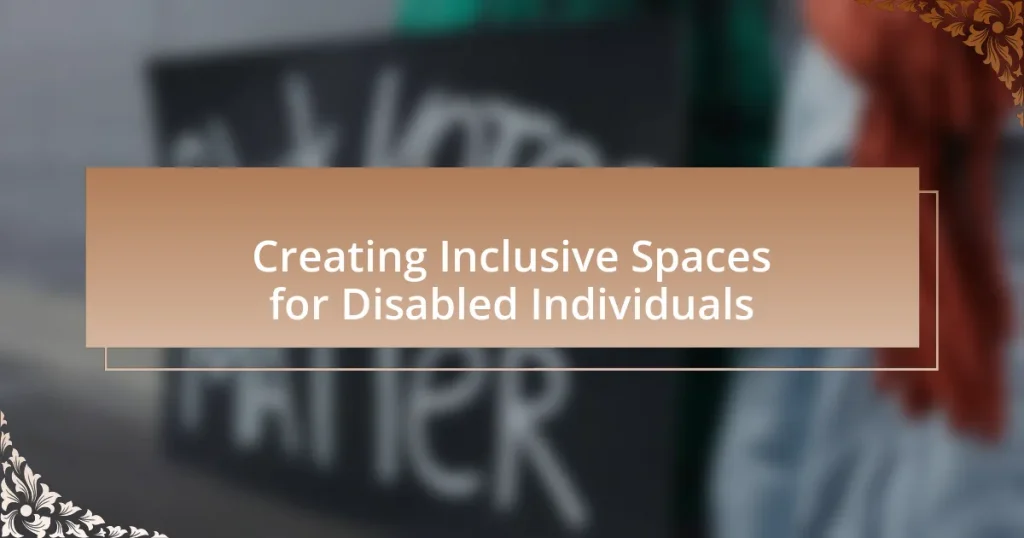Creating inclusive spaces for disabled individuals involves designing environments that ensure equal access and participation, incorporating features such as wheelchair ramps, accessible restrooms, and clear signage. The article emphasizes the importance of inclusivity in both public and private spaces, highlighting its benefits for social interaction, community engagement, and overall quality of life for disabled individuals. It discusses the societal advantages of inclusive environments, including enhanced economic productivity and reduced stigma. Key principles of inclusive design, common barriers faced by disabled individuals, and strategies for implementing inclusive practices are also explored, alongside the role of technology and community involvement in fostering accessibility.

What does it mean to create inclusive spaces for disabled individuals?
Creating inclusive spaces for disabled individuals means designing environments that accommodate and empower people with disabilities, ensuring equal access and participation. This involves implementing features such as wheelchair ramps, accessible restrooms, and clear signage, which facilitate mobility and navigation. According to the Americans with Disabilities Act (ADA), public spaces must be accessible to individuals with disabilities, highlighting the legal and ethical obligation to create such environments. Furthermore, inclusive spaces promote social interaction and community engagement, fostering a sense of belonging and reducing stigma associated with disabilities.
Why is inclusivity important in public and private spaces?
Inclusivity is important in public and private spaces because it ensures equal access and participation for all individuals, including those with disabilities. By creating environments that accommodate diverse needs, society fosters a sense of belonging and reduces barriers that marginalized groups face. Research indicates that inclusive spaces can enhance social interactions and improve mental well-being, as evidenced by a study published in the Journal of Environmental Psychology, which found that inclusive design positively impacts community engagement and individual satisfaction. Thus, prioritizing inclusivity not only benefits individuals with disabilities but also enriches the overall community experience.
How does inclusivity impact the quality of life for disabled individuals?
Inclusivity significantly enhances the quality of life for disabled individuals by providing equal access to opportunities and resources. When environments are designed to be inclusive, disabled individuals experience improved social interactions, increased independence, and better mental health outcomes. Research indicates that inclusive practices, such as accessible public spaces and inclusive education, lead to higher levels of participation in community activities, which fosters a sense of belonging and reduces feelings of isolation. For instance, a study published in the “Journal of Disability Policy Studies” found that inclusive educational settings positively influence the academic and social development of students with disabilities, thereby enhancing their overall quality of life.
What are the societal benefits of creating inclusive environments?
Creating inclusive environments fosters social cohesion and enhances community well-being. These environments promote diversity, allowing individuals from various backgrounds, including those with disabilities, to participate fully in society. Research indicates that inclusive settings lead to increased economic productivity; for instance, a study by the McKinsey Global Institute found that companies with diverse workforces are 35% more likely to outperform their peers financially. Furthermore, inclusive environments reduce stigma and discrimination, contributing to improved mental health outcomes for marginalized groups. By facilitating equal access to opportunities, inclusive spaces empower individuals, leading to a more equitable society overall.
What are the key principles of designing inclusive spaces?
The key principles of designing inclusive spaces include accessibility, usability, and adaptability. Accessibility ensures that all individuals, regardless of ability, can enter, navigate, and use the space effectively. Usability focuses on creating environments that are intuitive and easy to use for everyone, including those with disabilities. Adaptability allows spaces to be modified or adjusted to meet the diverse needs of users over time. These principles are supported by guidelines such as the Americans with Disabilities Act (ADA), which outlines specific requirements for physical spaces to promote inclusivity.
How can universal design principles be applied?
Universal design principles can be applied by integrating accessibility features into the design process from the outset, ensuring that environments are usable by all individuals, regardless of their abilities. This includes implementing features such as ramps, wider doorways, adjustable furniture, and clear signage, which accommodate diverse needs. Research by the Center for Universal Design at North Carolina State University highlights that environments designed with universal principles not only benefit individuals with disabilities but also enhance usability for everyone, demonstrating the effectiveness of these principles in creating inclusive spaces.
What role does accessibility play in inclusive design?
Accessibility is a fundamental component of inclusive design, ensuring that products, environments, and services are usable by people of all abilities. By integrating accessibility into the design process, creators can eliminate barriers that prevent individuals with disabilities from fully participating in society. Research indicates that approximately 15% of the global population experiences some form of disability, highlighting the necessity for designs that accommodate diverse needs. Furthermore, the World Health Organization emphasizes that inclusive design not only benefits individuals with disabilities but also enhances usability for all users, thereby fostering a more equitable environment.

What are the common barriers faced by disabled individuals in accessing spaces?
Disabled individuals commonly face physical barriers, such as inaccessible buildings and transportation systems, which hinder their ability to access spaces. For instance, a report by the U.S. Access Board indicates that many public facilities lack ramps, elevators, and accessible restrooms, making it difficult for individuals with mobility impairments to navigate these environments. Additionally, social barriers, including negative attitudes and lack of awareness among the public, further complicate access. According to a study published in the Journal of Disability Policy Studies, these social perceptions can lead to exclusionary practices that prevent disabled individuals from fully participating in community life.
What physical barriers hinder access for disabled individuals?
Physical barriers that hinder access for disabled individuals include steps, narrow doorways, and lack of ramps. Steps create obstacles for individuals using wheelchairs or mobility aids, while narrow doorways can prevent access for those with larger mobility devices. Additionally, the absence of ramps limits entry to buildings and public spaces, making it difficult for individuals with mobility impairments to navigate their environments. According to the Americans with Disabilities Act (ADA), these barriers violate accessibility standards, highlighting the need for inclusive design in public and private spaces.
How do architectural features affect accessibility?
Architectural features significantly affect accessibility by determining how easily individuals with disabilities can navigate and use a space. Features such as ramps, door widths, and the presence of elevators directly influence the ability of people with mobility impairments to enter and move within buildings. For instance, the Americans with Disabilities Act (ADA) mandates that public buildings include accessible entrances and pathways, which has been shown to improve access for individuals with disabilities by up to 80% in compliant structures. Additionally, tactile surfaces and auditory signals enhance navigation for those with visual or hearing impairments, further demonstrating that thoughtful architectural design can create inclusive environments.
What are the common design flaws that create obstacles?
Common design flaws that create obstacles for disabled individuals include inadequate accessibility features, poor spatial layout, and lack of sensory considerations. Inadequate accessibility features, such as insufficient ramps or door widths, hinder mobility for wheelchair users. Poor spatial layout can lead to cramped spaces that restrict movement and navigation, making it difficult for individuals with mobility impairments to maneuver. Additionally, lack of sensory considerations, like insufficient lighting or unclear signage, can create challenges for individuals with visual impairments. These flaws collectively contribute to an environment that is not inclusive, limiting the ability of disabled individuals to fully engage with spaces designed for public use.
What social barriers contribute to exclusion?
Social barriers that contribute to exclusion include stigma, lack of awareness, and inadequate accessibility. Stigma surrounding disabilities often leads to negative stereotypes and discrimination, which can isolate individuals from social interactions and opportunities. Lack of awareness about the needs and capabilities of disabled individuals results in insufficient support and resources, further perpetuating exclusion. Additionally, inadequate accessibility in public spaces, transportation, and communication limits participation in community activities, reinforcing social isolation. These barriers collectively hinder the integration of disabled individuals into society, as evidenced by studies showing that environments lacking inclusivity significantly impact the quality of life for disabled persons.
How does stigma affect the inclusion of disabled individuals?
Stigma significantly hinders the inclusion of disabled individuals by perpetuating negative stereotypes and misconceptions about their abilities. This societal bias often leads to discrimination in various settings, including workplaces, educational institutions, and social environments, which can result in limited opportunities for participation and engagement. Research indicates that individuals with disabilities face higher rates of unemployment and social isolation, largely due to the stigma surrounding their conditions. For instance, a study published in the Journal of Disability Policy Studies found that 70% of employers expressed concerns about hiring individuals with disabilities, primarily due to misconceptions about productivity and capability. This stigma not only affects the self-esteem and mental health of disabled individuals but also reinforces systemic barriers that prevent their full inclusion in society.
What role does awareness and education play in overcoming social barriers?
Awareness and education are crucial in overcoming social barriers by fostering understanding and empathy towards disabled individuals. When communities are educated about disabilities, they are more likely to challenge stereotypes and misconceptions, leading to increased acceptance and support. For instance, studies show that inclusive education programs significantly reduce prejudice among students, as seen in research conducted by the National Center for Learning Disabilities, which found that 70% of students in inclusive settings reported positive attitudes towards peers with disabilities. This shift in perception can lead to more inclusive policies and practices, ultimately creating environments where disabled individuals can thrive.

How can we effectively implement inclusive practices in various environments?
To effectively implement inclusive practices in various environments, organizations must adopt a multi-faceted approach that includes policy development, training, and community engagement. Establishing clear policies that promote accessibility and inclusion ensures that all individuals, regardless of ability, have equal opportunities to participate. Training staff on disability awareness and inclusive practices fosters a culture of understanding and support. Engaging with the community, particularly individuals with disabilities, allows organizations to identify specific needs and tailor their practices accordingly. Research indicates that inclusive environments not only benefit individuals with disabilities but also enhance overall organizational performance and morale, as demonstrated by a study from the American Psychological Association, which found that diverse teams are more innovative and effective.
What strategies can organizations adopt to promote inclusivity?
Organizations can adopt several strategies to promote inclusivity, particularly for disabled individuals. Implementing accessible design in physical spaces ensures that facilities are navigable for everyone, which is supported by the Americans with Disabilities Act (ADA) guidelines that mandate accessibility features. Additionally, providing training programs focused on disability awareness fosters a culture of understanding and respect among employees, as evidenced by studies showing that such training can reduce biases and improve workplace dynamics. Furthermore, organizations can establish employee resource groups that specifically address the needs and concerns of disabled individuals, creating a platform for advocacy and support. Lastly, actively seeking feedback from disabled employees about their experiences and needs can lead to continuous improvement in inclusivity efforts, as highlighted by research from the Job Accommodation Network, which indicates that inclusive practices enhance employee satisfaction and retention.
How can staff training enhance inclusivity in service-oriented spaces?
Staff training enhances inclusivity in service-oriented spaces by equipping employees with the knowledge and skills to effectively engage with diverse customers, including those with disabilities. Training programs that focus on disability awareness, communication techniques, and accessibility standards enable staff to recognize and address the unique needs of individuals with disabilities. For instance, a study by the National Center on Accessibility found that organizations that implemented comprehensive staff training saw a 30% increase in customer satisfaction among disabled patrons. This demonstrates that informed staff can create a welcoming environment, fostering positive interactions and ensuring that all customers feel valued and included.
What policies should be in place to support inclusive practices?
Policies that should be in place to support inclusive practices include anti-discrimination laws, accessibility standards, and diversity training programs. Anti-discrimination laws, such as the Americans with Disabilities Act (ADA), mandate equal opportunities for individuals with disabilities in various sectors, ensuring they are not excluded from employment, education, or public services. Accessibility standards, like the Web Content Accessibility Guidelines (WCAG), provide specific criteria for making digital content accessible, which is crucial in today’s technology-driven environment. Additionally, diversity training programs educate staff and management on the importance of inclusivity, fostering a culture that values diverse perspectives and experiences. These policies collectively create an environment that supports and empowers disabled individuals, promoting their full participation in society.
How can technology aid in creating inclusive spaces?
Technology can aid in creating inclusive spaces by providing tools and solutions that enhance accessibility for disabled individuals. For instance, assistive technologies such as screen readers, speech recognition software, and adaptive devices enable individuals with visual or mobility impairments to navigate environments more effectively. According to a report by the World Health Organization, approximately 15% of the global population experiences some form of disability, highlighting the need for inclusive design. Furthermore, smart building technologies can automate lighting and climate control, allowing users to customize their environment according to their specific needs. These advancements not only improve physical access but also foster a sense of belonging and participation in community activities for disabled individuals.
What assistive technologies are available to improve accessibility?
Assistive technologies available to improve accessibility include screen readers, speech recognition software, hearing aids, and mobility devices. Screen readers, such as JAWS and NVDA, convert text on a screen into speech, enabling visually impaired users to access digital content. Speech recognition software, like Dragon NaturallySpeaking, allows individuals with mobility impairments to control devices and dictate text using voice commands. Hearing aids amplify sound for individuals with hearing loss, enhancing their ability to communicate. Mobility devices, including wheelchairs and walkers, provide physical support and enhance mobility for individuals with physical disabilities. These technologies collectively contribute to creating inclusive environments by facilitating access to information and improving communication.
How can digital platforms enhance the experience of disabled individuals?
Digital platforms can enhance the experience of disabled individuals by providing accessible content and services tailored to their needs. These platforms often incorporate features such as screen readers, voice recognition, and customizable interfaces that allow users to navigate and interact more easily. For instance, according to the World Health Organization, over 1 billion people globally experience some form of disability, highlighting the necessity for digital inclusivity. Furthermore, studies show that accessible websites can increase user engagement by up to 83%, demonstrating the positive impact of digital platforms on the experiences of disabled individuals.
What are some best practices for creating inclusive spaces?
Best practices for creating inclusive spaces include ensuring physical accessibility, providing clear signage, and fostering a culture of respect and understanding. Physical accessibility can be achieved by incorporating ramps, wide doorways, and accessible restrooms, which comply with the Americans with Disabilities Act (ADA) standards. Clear signage, including Braille and large print, aids navigation for individuals with visual impairments. Additionally, fostering a culture of respect involves training staff on disability awareness and promoting inclusive policies, which has been shown to enhance participation and comfort for disabled individuals in various environments.
How can community involvement shape inclusive design?
Community involvement can significantly shape inclusive design by ensuring that the needs and preferences of diverse user groups are directly integrated into the design process. Engaging community members, particularly those with disabilities, allows designers to gather firsthand insights about accessibility challenges and preferences, leading to more effective solutions. For instance, studies have shown that participatory design approaches, where users actively contribute to the design process, result in products and environments that better meet their needs. This is supported by research from the University of Cambridge, which found that inclusive design outcomes improve when stakeholders, including disabled individuals, are involved in decision-making.
What are the key considerations when planning inclusive events?
Key considerations when planning inclusive events include accessibility, representation, and engagement. Accessibility ensures that venues are physically accessible to individuals with disabilities, including features like ramps, elevators, and accessible restrooms. Representation involves including diverse voices in the planning process, ensuring that the needs and preferences of disabled individuals are prioritized. Engagement focuses on creating an environment where all participants feel welcomed and valued, which can be achieved through inclusive programming and communication methods. Research indicates that events designed with these considerations can significantly enhance participation and satisfaction among disabled attendees, as highlighted in the “Inclusive Events: A Guide” by the National Center on Disability and Journalism.










